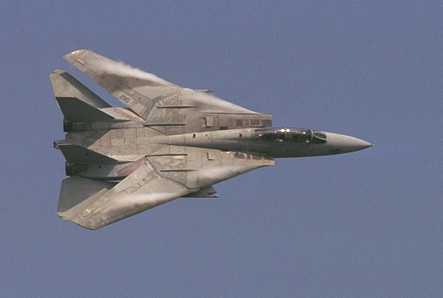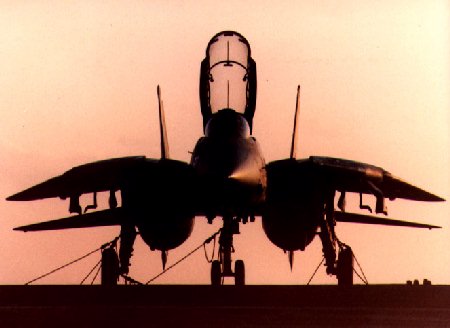F-14 Tomcat (Grumman Aerospace)
![]()
(Note: Links in italics are external links)
 The F-14 Tomcat is the Navy's premier multi-role, carrier based
aircraft. It is a two seat air- superiority fighter designed to deal with threats at
close, medium and long ranges. It is powered by 2 27,080 lb thrust General Electric F-110-GE-400
augmented afterburning turbo fans (B&D models) giving it a maximum high altitude speed
of Mach 1.88. Earlier A models used the Pratt & Whitney TF30P-414-A afterburning
turbofan at 20,900 lbs. thrust.
The F-14 Tomcat is the Navy's premier multi-role, carrier based
aircraft. It is a two seat air- superiority fighter designed to deal with threats at
close, medium and long ranges. It is powered by 2 27,080 lb thrust General Electric F-110-GE-400
augmented afterburning turbo fans (B&D models) giving it a maximum high altitude speed
of Mach 1.88. Earlier A models used the Pratt & Whitney TF30P-414-A afterburning
turbofan at 20,900 lbs. thrust.
The Tomcat is a large aircraft at nearly 62 ft. in length and has a wing span of 64' 2" or 38' 2" swept and is 16' tall. It has a maximum weight of 72,900 lbs. Although it is large it is very maneuverable and is considered an excellent dog fighter.
The F-14 carries AIM-9 Sidewinder air-to-air missiles and Martin Marietta (General Electric) M61A1 20mm "Vulcan" cannon with 675 rounds of ammunition for close range combat. AIM-7 Sparrows deal with medium range threats and the AIM-54 Phoenix is used for threats up to 100 miles away. The Hughes AWG-9, APG-71 electronic warfare package carried by the F-14 allows it to track up to 24 targets at once and lock and fire on up to 6. Some F14-Ds are fitted with the Tactical Airborne Reconnaissance Pod System (TARPS).
The F-14 opened its score on 19 August 1981, when F-14 pilots Lt. Larry Muszynski and Cdr. Hank Kleeman of VF-41 "Black Aces" squadron destroyed a pair of marauding Libyan Sukhoi Su-22 "Fitters". Two MIG-23s fell to F-14s in a similar incident during 1989.
The original F14-A first flew on 21 December 1970 and entered Navy service in 1974.

Click on the thumbnail and check out this
flyby
Super Tomcat 21
The Super Tomcat 21 is a proposed multi-role
adaptation of the F-14D Tomcat. It was proposed as a low-cost alternative to the Naval
ATF, and drew heavily on the work done on Grumman's "Quickstrike" proposal.
Like the "Quickstrike", the Super Tomcat 21 was to have a FLIR, and was to be
provided with more modes for its APG-71 radar, such as synthetic aperature and Doppler
Beam Sharpening for mapping. Four underfuselage hardpoints would have five munitions
substations each, while the two wing glove pylons would have two substations. Naviagation
and targeting pods could be installed. The Super Tomcat 21 differed, however, from the
Quickstrike in making an attempt to reduce its radar cross section by a significant
amount. In addition, it was to have been powered by improved F110-GE-129
turbofan engines which offered "supercruise" (the ability to achieve sustained
supersonic cruising speeds without the need for afterburning) and would even have included
thrust vectoring capability. The Super Tomcat 21 would also have featured enlarged
tailplanes with extended trailing edges giving greater area, plus newly-configured wing
gloves housing additional internal fuel.
It would also have featured increased-lift slotted flaps and extended-chord leading edeg
wing slats to allow no-wind carrier takeoffs or conventional carrier takeoffs at higher
loaded weights. A new more powerful radar suite would be fitted, and the weapons delivery
capability would be markedly enhanced by the adoption of helmet-mounted sights.
The Attack Super Tomcat 21 was based on the Super Tomcat 21 but had thicker outer wing
panels that carried more fuel. In addition, the aircraft would have provision for carrying
larger external fuel tanks. Refinements to the leading-edge slats and the trailing-edge
flaps were to give a 18-mph reduction in the landing approach speed. The aircraft was to
have had the Norden radar that had been developed for the abortive General
Dynamics/McDonnell Douglas A-12 Avenger II. The Attack Super Tomcat 21 has received quite
a bit of attention as a potential alternative to the cancelled A-12. However, in the
present military drawdown mode, both of these Tomcat 21 proposals share an uncertain
future.

The dawn of a new day in the life of a Tomcat

SPECIFICATIONS
Span: 61 ft. 10 in., 38ft. 3in. swept
Length: 61 ft. 9in.
Height: 16 ft.
Weight: Max takeoff: 72,900 lbs. max. takeoff
Crew: Two: pilot and radar intercept officer
Unit Cost: $38 million
Armament
One 20mm M-61A1 Vulcan cannon, 6 AIM-54 Phoenix missiles or
6 AIM-7 Sparrow missiles and 4 AIM-9 Sidewinder missiles, plus 14,300 lbs. mixed ordnance
carried externally.
.
PERFORMANCE
Engines: F-14A: Two Pratt & Whitney TF-30P-414A
turbofan engine with afterburners F-14B and F-14D: Two General Electric F110-GE-400
turbofan engines with afterburners
Maximum speed: Plus 1,584 mph. @ 40,000 ft. (Mach 2+)
Thrust: TF-30P-414A: 20,900 pounds (9,405 kg) static thrust per engine F110-GE-400:
27,000 pounds (12,150 kg) static thrust per engine
Combat Radius: 378 miles on internal fuel; 750 miles with two 130-gal. tanks.
Service Ceiling: Above 50,000 ft
Date Deployed: First flight: December 1970
U.S.Fighter
Home | Feedback